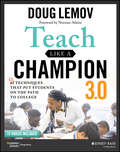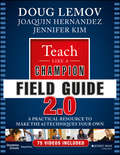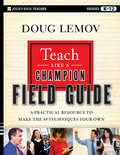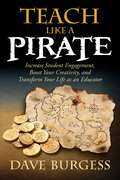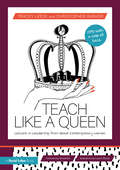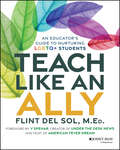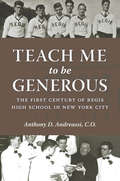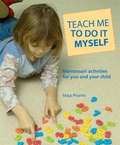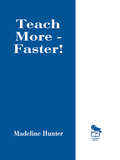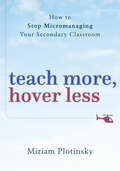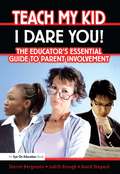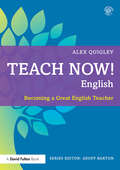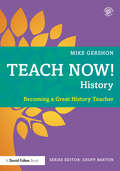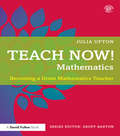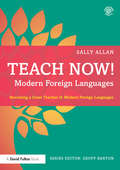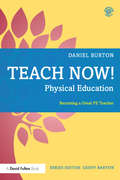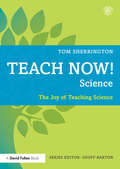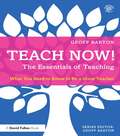- Table View
- List View
Teach Like a Champion 2.0: 62 Techniques that Put Students on the Path to College
by Doug Lemov Norman AtkinsOne of the most influential teaching guides ever—updated! Teach Like a Champion 2.0 is a complete update to the international bestseller. This teaching guide is a must-have for new and experienced teachers alike. Over 700,000 teachers around the world already know how the techniques in this book turn educators into classroom champions. With ideas for everything from classroom management to inspiring student engagement, you will be able to perfect your teaching practice right away. The first edition of Teach Like a Champion influenced thousands of educators because author Doug Lemov's teaching strategies are simple and powerful. Now, updated techniques and tools make it even easier to put students on the path to college readiness. Here are just a few of the brand new resources available in the 2.0 edition: Over 70 new video clips of real teachers modeling the techniques in the classroom A selection of never before seen techniques inspired by top teachers around the world Brand new structure emphasizing the most important techniques and step by step teaching guidelines Updated content reflecting the latest best practices from outstanding educators With the sample lesson plans, videos, and teachlikeachampion.com online community, you will be teaching like a champion in no time. The classroom techniques you'll learn in this book can be adapted to suit any context. Find out why Teach Like a Champion is a "teaching Bible" for so many educators worldwide.
Teach Like a Champion 3.0: 63 Techniques that Put Students on the Path to College
by Doug LemovTeach Like a Champion 3.0 is the long-awaited update to Doug Lemov’s highly regarded guide to the craft of teaching. This book teaches you how to create a positive and productive classroom that encourages student engagement, trust, respect, accountability, and excellence. In this edition, you’ll find new and updated teaching techniques, the latest evidence from cognitive science and culturally responsive teaching practices, and an expanded companion video collection. Learn how to build students’ background knowledge, move learning into long-term memory, and connect your teaching with the curriculum content for tangible improvement in learning outcomes. The new version of the book includes: An introductory chapter on mental models for teachers to use to guide their decision-making in the classroom. A brand new chapter on Lesson Preparation. 10 new techniques Updated and revised versions of all the technique readers know and use A brand new set of exemplar videos, including more than a dozen longer “keystone” videos which show how teachers combine and balance technique over a stretch of 8 to 10 minutes of teaching. Extensive discussion of research in social and cognitive science to support and guide the use of techniques. Additional online resources, and supports Read this powerful update to discover the techniques that leading teachers are using to put students on the path to success.
Teach Like a Champion Field Guide 2.0: A Practical Resource to Make the 62 Techniques Your Own
by Doug Lemov Jennifer Kim Joaquin HernandezThe must-have companion workbook to the bestselling Teach Like a Champion 2.0 Teach Like a Champion Field Guide 2.0 is the teacher's hands-on guide to improving their craft. In Teach Like a Champion 2.0, veteran teaching coach Doug Lemov updated, improved upon, and replaced the original edition of this global bestseller, setting forth 62 of the most rigorously vetted and critically observed teaching techniques around. Field Guide 2.0 is a practical workbook for these 62 techniques, outlining all the tools a teacher needs to make champion teaching a reality in their classroom starting now. Coauthored by fellow educators Joaquin Hernandez and Jennifer Kim, the book is a practical guide for adapting the techniques to fit classrooms and teachers everywhere. With over 75 video clips of the techniques in play and 100+ field-tested activities to boot, Field Guide 2.0 is the professional development tool every school leader dreams of. It's the teaching playbook that every teacher, principal, and coach should have in their library, chock-full of actionable tools that unlock a teacher's potential so they can push their students to do the same! The updated '2.0' version of Teach Like a Champion written to update, improve upon and replace the original Just like Teach Like a Champion Field Guide helped educators put the original 49 techniques into practice, Field Guide 2.0 is the ultimate resource for the 62 techniques in Teach Like a Champion 2.0. They're the most rigorous, champion-vetted techniques yet and this book takes you through them from top to bottom with the kind of clarity and breadth you've come to expect from the experts at Teach Like a Champion. The book includes: Practical approaches to each of the 62 techniques 75+ video clips with analysis of the techniques in play in the classroom Hands-on activities to bring the 62 techniques from the page into the classroom Teach Like a Champion 2.0 is a book by educators for educators. It's about giving teachers what they need to share their strengths so that every teacher, from first year rookie to third-year veteran, can approach their classes with the skills they need for their students to succeed. Teach Like a Champion Field Guide 2.0 is the indispensable guide to getting there, one technique at a time.
Teach Like a Champion Field Guide 3.0: A Practical Resource to Make the 63 Techniques Your Own
by Doug Lemov Erica Woolway Sadie McCleary Hannah SolomonCreate classroom excellence with this hands-on field guide to the TLAC techniques In Teach Like a Champion Field Guide 3.0, accomplished educators Doug Lemov, Sadie McCleary, Hannah Solomon and Erica Woolway deliver a practical and hands-on workbook to show educators how to practice the 63 teaching techniques presented in Teach Like a Champion 3.0, drive instruction, and develop teaching excellence The book offers video, tools, and engaging activities to guide the reader through each of the techniques, showing you how to apply them in the real world, both online and in-person. Readers will also learn to hone their craft with: Field-tested activities incorporating the lessons from Teach Like a Champion 3.0 Over 25 keystone videos, complete with analysis, from example classrooms and educators Strategies for creating the most vibrant classroom culture Insights on using video as a tool for professional development- especially for master teachers An advanced resource for teachers, professors, course creators, and anyone else who teaches material online or in-person, Teach Like a Champion Field Guide 3.0 create classrooms of rigor and excellence.
Teach Like a Champion: Field Guide
by Doug LemovThe companion to Teach Like a Champion, the book that took the teaching community by storm In his acclaimed book Teach Like a Champion, Doug Lemov shared 49 essential techniques used by excellent teachers. In his companion Field Guide, he further explores those techniques in a practical guide. With the Teach Like a Champion Field Guide, teachers will have an indispensable resource that complements their classroom application of Lemov's techniques. The activities are designed to accompany the practitioner on the journey to become a champion teacher. The activities span three stages: learning the techniques, preparing to use the techniques, and actual practice. In addition to developing and sharpening teaching techniques, the activities provide a proven system for assessing outcomes. The book includes thirty new video clips of champion teachers with analysis from the author. It also includes helpful charts for teachers to track their own progress and to record feedback from colleagues. Most importantly, by using the Field Guide, teachers will be prepared to successfully unlock the talent and skill in all their students. A hands-on exploration of 49 techniques that are guaranteed to boost success in the classroom Includes 30 video clips of champion teachers Written by Doug Lemov, bestselling author of Teach Like a Champion Teach Like a Champion Field Guide is a must-have workbook for every teacher, from beginner to veteran. The workbook is also a great tool for professional development.
Teach Like a Pirate: Increase Student Engagement, Boost Your Creativity, and Transform Your Life as an Educator
by Dave BurgessBased on Dave Burgess's popular "Outrageous Teaching" and "Teach Like a PIRATE" seminars, this book offers inspiration, practical techniques, and innovative ideas that will help you to increase student engagement, boost your creativity, and transform your life as an educator. You'll learn how to: -Tap into and dramatically increase your passion as a teacher -Develop outrageously engaging lessons that draw students in like a magnet -Establish rapport and a sense of camaraderie in your classroom -Transform your class into a life-changing experience for your students This groundbreaking inspirational manifesto contains over 30 hooks specially designed to captivate your class and 170 brainstorming questions that will skyrocket your creativity. Once you learn the Teach Like a PIRATE system, you'll never look at your role as an educator the same again.
Teach Like a Queen: Lessons in Leadership from Great Contemporary Women
by Tracey Leese Christopher BarkerTeach Like a Queen explores teacher leadership like never before... This exciting and unique text brings together leadership theory, popular culture and action research to inspire and empower female teachers into leadership roles. Teach Like a Queen celebrates the successes of iconic women and translates their respective brilliance into becoming successful, dynamic and high-performing practitioners and educational leaders. Focusing on seven key inspirational women as archetypes, the authors address emerging professional issues which will benefit classroom practitioners and leaders, each correlating to a different Nolan principle and inspirational queen. Inspired by the incredible work of WomenEd, including a Foreword from Vivienne Porritt, each lesson features: a constructed definition of each respective icon and how that translates into the teaching profession; a case study exploring how a female school leader experienced her own Queen moment and the leadership lesson it taught her; key lessons for aspiring leaders; and takeaway actions to channel your inner queen. Illustrating how a diverse cross-section of women personify the leadership strength of their assigned principle in practice, Teach Like a Queen will empower female teachers to aspire to lead and equip them with practical strategies to secure and fulfil leadership roles.
Teach Like an Ally: An Educator's Guide to Nurturing LGBTQ+ Students
by Flint Del SolAnswers to all your burning questions and practical advice for helping LGBTQ+ students thrive In Teach Like an Ally: An Educator's Guide to Nurturing LGBTQ+ Students, veteran classroom teacher and celebrated transgender advocate Flint Del Sol weaves humor, storytelling, and expertise into a hands-on guide for educator-allies. Del Sol offers actionable strategies that you can implement in classrooms right away. He also tackles the complex questions teachers face: What should you do when a student asks for one name in the classroom, but another at home? Or when you're sure a student is trans, but they haven't said anything to you? How do you know your bathroom pass policy isn't hurting your most vulnerable students? What do you do when your values are at odds with school policy? Building a positive school climate doesn't have to be intimidating. In Teach Like an Ally, you'll learn how educators can support each other and how we can all give LGBTQ+ students the best possible chance to flourish. Get candid answers to difficult questions about LGBTQ+ students in the classroom Become a stronger ally by understanding what LGBTQ+ students go through in secondary school settings Learn the research-backed practices you can implement to make your classroom a safe space for all Support all students in developing compassion and understanding for one another This pragmatic book is for teachers, administrators, families, and anyone committed to the wellbeing of LGBTQ+ students in secondary classrooms.
Teach Me
by R. A. NelsonTeach Me invites readers inside an experience that fascinates everyone-an affair between a teacher and student-and gives an up-close-and-personal answer to the question: How does this happen?
Teach Me to Be Generous: The First Century of Regis High School in New York City
by Anthony D. Andreassi C.O.Teach Me to Be Generous tells the remarkable story of Regis High School, the Jesuit school on New York’s Upper East Side that was founded in 1914 by an anonymous donor as a school for Catholic boys whose families could not otherwise afford a Catholic education. Enabled by the philanthropy of the founding family for nearly a century, and now by alumni and friends carrying on that tradition of generosity, Regis has been able to provide tuition-free, all-scholarship education for its entire history. It also holds the distinction of being the first free-standing Jesuit high school in the United States, with no connection to any Jesuit colleges or universities.Regis High School’s unique story is told by an engaging storyteller and historian who has taught at the school for more than ten years. Father Andreassi offers captivating glimpses into the lives and daily experiences of Regis’s students and faculty while chronicling the development of the school’s educational philosophyand spiritual approach in its first century. Filled with entertaining anecdotes alongside wider historical context and illuminating statistical analysis, Teach Me to Be Generous tracks Regis High School through the decades of the twentieth century to the present day—from the generosity of a devout Catholic widow, through the Depression and World War II, to changes in demographics of the Catholic community and shifts in the landscape of Catholic education in New York City. During the school’s first few decades, Regis admitted thousands of Catholic boys, mostly from poor or lower-middle-class families, helping prepare them for success in college and leadership positions in the professions. Because of the closing of dozens of urban Catholic schools and the general decline of the quality of New York City’s public schools, in more recent years the school has faced the challenge of remaining true to its mission in offering an education to Catholic boys “who otherwise would not be able to afford a Catholic education.”Teach Me to Be Generous paints a vivid portrait of the first one hundred years of an exceptional institution and looks with hope and confidence to its future.
Teach Me to Do It Myself: Montessori Activities for You and Your Child
by Maja PitamicBased on the key Montessori principle that children learn best through active experience, Teach Me to Do It Myself presents simple activities through which children explore and develop their skills. These skill areas include sensory perceptions, body coordination, language, understanding of numbers, and movement. This practical, color-illustrated parenting book is filled with activities and instructions for overseeing children as they carry out a variety of learning activities. Most activities will seem simple to parents, because once mastered, adults perform them automatically. However, toddlers experience a sense of accomplishment and self-worth when they learn to perform them independently. The many activities start with dressing and personal hygiene, then go on to include ... Pouring activities; Threading and sewing activities; Peg activities; Cutting with scissors; Sorting activities by touch; A color matching game; Making musical scales with bottles and water; Using alphabet tiles to make words; Growing things in a window box; Making finger puppets. Activities are described in detail and include checklists of needed items, as well as variations and related activities for children to try.
Teach Me, I Dare You!: The Educator's Essential Guide To Parent Involvement
by Sherrell Bergmann Judith Brough Larry HoltThis book provides practical tools for educators who work with disenchanted and disengaged youths. It offers clear, research-based, and explicit strategies for motivating, connecting, and intervening with these students. The practical wisdom in this book demonstrates what you can do to connect these students to their schools and to a promising future.
Teach More -- Faster!
by Madeline HunterThe elements which influence a student's rate and degree of learning are outlined in this volume. Madeline Hunter demonstrates a diversity of practical teaching techniques, including how to design practice so that it does `make perfect' and how to avoid the `black holes' in any sequence of learning.
Teach More and Discipline Less: Preventing Problem Behaviors in the K-6 Classroom
by Barbara ReiderDrawing on the wisdom of master teachers and her own extensive classroom experience, Reider explains how to empower students while establishing an "invisible" authority in the classroom.
Teach More, Hover Less: How To Stop Micromanaging Your Secondary Classroom
by Miriam PlotinskyA hover-free classroom starts with a dynamic class community. Our image of a classroom community in secondary education is rapidly evolving. The experience of remote learning during a pandemic has altered our mental picture of students occupying rows of desks with a teacher nearby, closely monitoring their activities. But even when teachers are able to be in physical proximity to their students, the research is clear that students need to be empowered to take ownership of their learning in order to be fully engaged. The question this book explores is: How can teachers step back, stop micromanaging, and allow students more agency? In this engaging guide, instructional specialist Miriam Plotinsky breaks hover-free teaching down into four sequential stages: mindset, deeper relationships, planning for engagement, and choice-based instruction. Her book shows how teachers can free themselves from helicopter habits and allow students greater control of their own learning, while still managing and maximizing classroom time effectively.
Teach My Kid- I Dare You!: The Educator's Essential Guide to Parent Involvement
by David Shepard Sherrell Bergmann Judith BroughThis book shows you how to positively involve parents to raise student achievement. It offers 10 steps for designing a comprehensive parent involvement program to increase communication between students, parents, and schools. The authors offer practical strategies and activities for involving all parents, monitoring under-involved parents, balancing over-involved parents, and assisting parents in urgent situations.
Teach Now! English: Becoming a Great English Teacher (Teach Now!)
by Alex QuigleyBeing taught by a great teacher is one of the great privileges of life. Teach Now! is an exciting new series that opens up the secrets of great teachers and, step-by-step, helps trainees to build the skills and confidence they need to become first-rate classroom practitioners. Written by a highly-skilled practitioner, this practical, classroom-focused guide contains all the support you need to become a great English teacher. Combining a grounded, modern rationale for learning and teaching with highly practical training approaches, the book guides you through all the different aspects of English teaching offering clear, straightforward advice on classroom practice, lesson planning and working in schools. Celebrating the values of English teaching, Alex Quigley sets out a ‘steps to success’ model that will help you to go from novice to expert teacher. The English curriculum, planning, assessment, behaviour management, literacy and differentiation are all discussed in detail alongside carefully chosen examples to demonstrate good practice. There are also chapters on dealing with pressure, excelling in observations, finding the right job and succeeding at interview. Throughout the book, there is a great selection of ready-to-use activities and techniques, including effective reading and writing strategies, pedagogies for teaching poetry and Shakespeare, and how to harness the power of debate, dialogue and drama, all of which will help you overcome any challenges and put you on the fast track to success in the classroom. Covering everything you need to know, this book is your essential guide as you start your exciting and rewarding career as an outstanding English teacher.
Teach Now! History: Becoming a Great History Teacher (Teach Now!)
by Mike GershonBeing taught by a great teacher is one of the great privileges of life. Teach Now! is an exciting new series that opens up the secrets of great teachers and, step-by-step, helps trainees to build the skills and confidence they need to become first-rate classroom practitioners. Written by a highly-skilled practitioner, this practical, classroom-focused guide contains all the support you need to become a great history teacher who inspires and motivates students to critically and creatively explore the past. Combining a grounded, modern rationale for learning and teaching with highly practical training approaches rooted in the realities of the classroom, the book guides you through all the different aspects of history teaching offering clear, straightforward advice on classroom practice, lesson planning and working in schools. Teaching and learning, planning, assessment and behaviour management are all covered in detail, with a host of carefully chosen examples used to demonstrate good practice and show how to facilitate outstanding historical enquiry. There are also chapters on dealing with pressure, excelling in observations, finding the right job and succeeding at interview. Throughout the book, there is a great selection of ready-to-use activities, strategies and techniques which will help put you on the fast track to success in the classroom; and ensure your students are doing the very best learning possible. Covering everything you need to know, this book is your essential guide as you start your exciting and rewarding career as an outstanding history teacher.
Teach Now! Mathematics: Becoming a Great Mathematics Teacher (Teach Now!)
by Julia UptonBeing taught by a great teacher is one of the great privileges of life. Teach Now! is an exciting new series that opens up the secrets of great teachers and, step-by-step, helps trainees to build the skills and confidence they need to become first-rate classroom practitioners. Written by a highly-skilled practitioner, this practical, classroom-focused guide contains all the support you need to become a great mathematics teacher. Combining a grounded, modern rationale for learning and teaching with highly practical training approaches, the book guides you through the themes of mathematics teaching and the skills needed to demonstrate learning. Teach Now! Mathematics also offers clear, straightforward advice on classroom practice, lesson planning and working in schools. Teaching and learning, planning, assessment and behaviour management are all covered in detail, with a host of carefully chosen examples used to demonstrate good practice. Every example is rooted in recent experience in the mathematics classroom. The commonalities of teaching pedagogy across all subjects are discussed but this book gets to the heart of the unique nature of this subject. From building confidence to developing problem-solving skills and mathematical literacy, this book considers what the keys to success are in learning, and hence teaching, mathematics. There are also chapters on dealing with pressure, excelling in observations, finding the right job and succeeding at interview. Throughout the book, there is a great selection of ready-to-use activities, strategies and techniques which will help put you on the fast track to success in the classroom. With a strong emphasis on sparking students' interest and enthusiasm in mathematics, this book is your essential guide as you start your exciting and rewarding career as an outstanding mathematics teacher.
Teach Now! Modern Foreign Languages: Becoming a Great Teacher of Modern Foreign Languages (Teach Now!)
by Sally AllanBeing taught by a great teacher is one of the great privileges of life. Teach Now! is an exciting new series that opens up the secrets of great teachers and, step-by-step, helps trainees to build the skills and confidence they need to become first-rate classroom practitioners. Written by a highly-skilled practitioner, this practical, classroom-focused guide contains all the support you need to become a great modern foreign languages teacher. Combining a grounded, modern rationale for learning and teaching with highly practical training approaches, the book guides you through all the different aspects of MFL teaching offering clear, straightforward advice on classroom practice, lesson planning and working in schools. Teaching and learning, planning, assessment and behaviour management are all covered in detail, with a host of carefully chosen examples used to demonstrate good practice. There are also chapters on the essentials of the MFL curriculum, pedagogical techniques, strategies to engage students in language learning, and how to succeed in observations and interviews. Throughout the book, there is a great selection of ready-to-use activities, approaches and techniques which will help put you on the fast track to success in the classroom. Covering everything you need to know, this book is your essential guide as you start your exciting and rewarding career as an outstanding MFL teacher.
Teach Now! Physical Education: Becoming a Great PE Teacher (Teach Now!)
by Daniel BurtonBeing taught by a great teacher is one of the great privileges of life. Teach Now! is an exciting series that opens up the secrets of great teachers and, step by step, helps trainees, or teachers new to the profession, to build the skills and confidence they need to become first-rate classroom practitioners. Written by a highly-skilled practitioner, this accessible guide contains all the support you need to become a great Physical Education teacher. Combining a grounded, modern rationale for teaching with highly practical training approaches, the book offers clear, straightforward advice on effective practice which will develop students' physical literacy, knowledge and inter-personal skills. Enhanced by carefully chosen examples to demonstrate good practice, and with key definitions and ready-to-use activities included throughout, the book examines the aims and value of teaching PE, and outlines the essential components of providing a good Physical Education to students of all ages and abilities. Planning, assessment and behaviour management are all covered in detail, alongside chapters which focus upon the criteria and objectives of an effective PE curriculum, how to support students with special educational needs and physical disabilities, and how to create practical and effective ways to cater for the most-able students within PE. Teach Now! Physical Education contains all the support required by trainee or newly qualified PE teachers. With advice on job applications, interviews, and your very first term, this book is your essential guide as you start your exciting career as an outstanding Physical Education teacher.
Teach Now! Science: The Joy of Teaching Science (Teach Now!)
by Tom SherringtonBeing taught by a great teacher is one of the great privileges of life. Teach Now! is an exciting new series that opens up the secrets of great teachers and, step-by-step, helps trainees to build the skills and confidence they need to become first-rate classroom practitioners. Written by a highly-skilled practitioner, this practical, classroom-focused guide contains all the support you need to become a great science teacher. Combining a grounded, modern rationale for learning and teaching with highly practical training approaches, the book guides you through all the different aspects of science teaching offering clear, straightforward advice on classroom practice, lesson planning and working in schools. Teaching and learning, planning, assessment and behaviour management are all covered in detail, with a host of carefully chosen examples used to demonstrate good practice. There are also chapters on organising practical work, the science curriculum, key ideas that underpin science as a subject and finding the right job. Throughout the book, there is a wide selection of ready-to-use activities, strategies and techniques to help you bring science alive in all three main disciplines, including common experiments and demonstrations from biology, physics and chemistry to engage and inspire you and your students. Celebrating the whole process of engaging young people with the awe and wonder of science, this book is your essential guide as you start your exciting and rewarding career as an outstanding science teacher.
Teach Now! The Essentials of Teaching: What You Need to Know to Be a Great Teacher (Teach Now!)
by Geoff BartonBeing taught by a great teacher is one of the great privileges of life. Teach Now! is an exciting new series that opens up the secrets of great teachers and, step-by-step, helps trainees to build the skills and confidence they need to become first-rate classroom practitioners. Teach Now! The Essentials of Teaching provides the fundamental knowledge for becoming a great teacher. Combining a grounded, modern rationale for learning and teaching with highly practical training approaches it covers everything you need to know from preparing for your teaching practice to getting your first job. Harnessing a range of simple, but powerful techniques, the book shows you how you can translate the Teachers’ Standards into your own classroom practice and provide the evidence that you have met them. It also demystifies what the best teachers know and do instinctively to create students who want to learn and get a buzz from developing new skills. The book is structured in clear sections which are then divided into short, easy-to-absorb units offering clear, straightforward advice on all aspects of teaching including: why teach? the application and recruitment process for training helping students’ achieve good progress planning, differentiation and assessment behaviour management using language effectively in the classroom managing parents’ evenings being an effective tutor how to have lunch! With talking points to encourage reflection and a wide range of examples to illustrate practice, Teach Now! The Essentials of Teaching provides expert guidance as you start your exciting and rewarding career as an outstanding teacher.
Teach Reading with Orton-Gillingham: 65 Classroom-Ready Lessons to Help Struggling Readers and Students with Dyslexia Learn to Love Reading
by Kristina Smith Heather MacLeod-VidalGive young readers the tools they need to improve reading fluency and master letter-sound relationships with this teacher-friendly book of multisensory lessons based on the proven Orton-Gillingham (OG) reading approach. Bringing Orton-Gillingham and multisensory teaching into your classroom has never been easier. With this big book of easy-to-follow lesson plans, you can help your struggling students or those with dyslexia start reading today. Teach Reading with Orton-Gillingham offers research-based suggestions and instructions to make reading multisensory and engaging. Whether it&’s using sand or shaving cream, there are tons of fun, proven ideas and strategies to help your students better understand key concepts like letter-sound relationships. With 9 unique units and 72 different lesson plans, each unit will include lessons, tips, pictures, reference charts, suggested teaching timelines, and more resources. Also included are strategies for customizing this approach, whether you&’re working one-on-one, within small groups, or in a whole-class setting.
Teach Reading with Orton-Gillingham: A Companion Guide with Dictation Activities, Decodable Passages, and Other Supplemental Materials for Struggling Readers and Students with Dyslexia
by Kristina Smith Heather MacLeod-VidalA Simon & Schuster eBook. Simon & Schuster has a great book for every reader.

